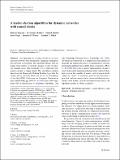A leader election algorithm for dynamic networks with causal clocks
Author(s)
Ingram, Rebecca; Shields, Patrick; Viqar, Saira; Walter, Jennifer E.; Welch, Jennifer L.; Radeva, Tsvetomira T.; ... Show more Show less
Download446_2013_Article_184.pdf (1.245Mb)
PUBLISHER_POLICY
Publisher Policy
Article is made available in accordance with the publisher's policy and may be subject to US copyright law. Please refer to the publisher's site for terms of use.
Terms of use
Metadata
Show full item recordAbstract
An algorithm for electing a leader in an asynchronous network with dynamically changing communication topology is presented. The algorithm ensures that, no matter what pattern of topology changes occurs, if topology changes cease, then eventually every connected component contains a unique leader. The algorithm combines ideas from the Temporally Ordered Routing Algorithm for mobile ad hoc networks (Park and Corson in Proceedings of the 16th IEEE Conference on Computer Communications (INFOCOM), pp. 1405–1413 (1997) with a wave algorithm (Tel in Introduction to distributed algorithms, 2nd edn. Cambridge University Press, Cambridge, MA, 2000), all within the framework of a height-based mechanism for reversing the logical direction of communication topology links (Gafni and Bertsekas in IEEE Trans Commun C–29(1), 11–18 1981). Moreover, a generic representation of time is used, which can be implemented using totally-ordered values that preserve the causality of events, such as logical clocks and perfect clocks. A correctness proof for the algorithm is provided, and it is ensured that in certain well-behaved situations, a new leader is not elected unnecessarily, that is, the algorithm satisfies a stability condition.
Date issued
2013-02Department
Massachusetts Institute of Technology. Department of Electrical Engineering and Computer ScienceJournal
Distributed Computing
Publisher
Springer-Verlag
Citation
Ingram, Rebecca, Tsvetomira Radeva, Patrick Shields, Saira Viqar, Jennifer E. Walter, and Jennifer L. Welch. "A leader election algorithm for dynamic networks with causal clocks." Distributed Computing, vol. 26, issue 2, April 2013, pp. 75-97.
Version: Author's final manuscript
ISSN
0178-2770
1432-0452